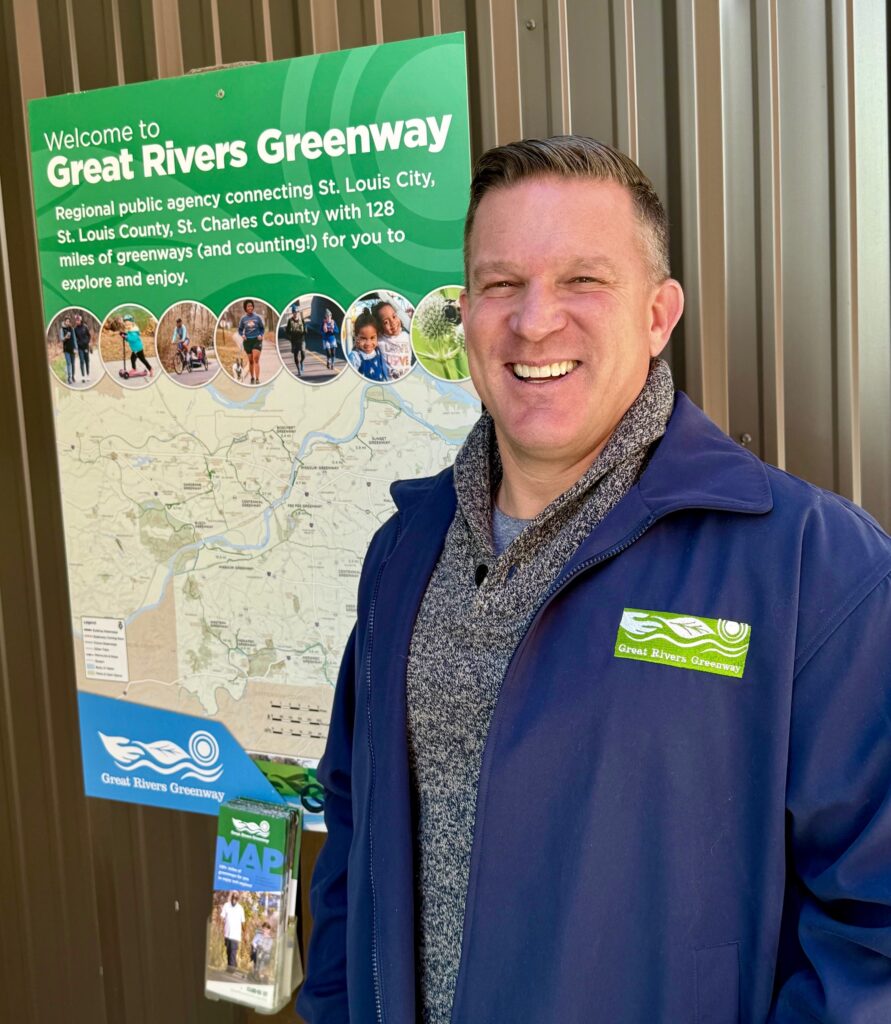-Todd Antoine, Chief of Planning and Projects, Great Rivers Greenway
Twenty-three years is a long time for someone to be a part of any organization. When I joined Great Rivers Greenway in early 2002 as employee number three, my role as a senior planner was to give our regional community tangible examples of how their tax money was being used to their benefit. Now as our chief of planning and projects, my and our agency’s goals have grown and adapted to fit the evolving needs and mindsets of our unique regional community. To match that regional uniqueness, we’ve become something of a unicorn as not only one of the few public agencies dedicated fully to the creation and maintenance of urban greenways and trails, but also as possibly the only agency of this function funded by a dedicated sales tax. That vision has painted our region with a growing network of intertwined greenways, connecting hundreds of neighborhoods across 135 miles of paved pathways, accessible to all.



Moving Targets
My early years with Great Rivers Greenway were often defined by producing a physical manifestation of our work, something to demonstrate to the region’s taxpayers that their funds were working for them and to build trust that they weren’t being lost among bureaucracy and committee meetings. This meant quantifying our success and contribution with however many miles of greenways we had built, the number of trees planted or other metrics of that nature. As the years have come and gone, the region has shifted its expectations of us and our work. Our history as a financially efficient and ethical agency has encouraged this shift to a less transactional relationship with the region. We are now able to demonstrate and measure our contribution in the communities the greenways connect, in the programming they provide and opportunities they create.
Becoming A Leader
As the years have passed and Great Rivers Greenway has become a more established agency both regionally and among the national greenway community, its uniqueness has grown increasingly noteworthy. Just as the community it serves has. Chief among these unique qualities is our absolute focus on greenways; few agencies of our size and even less of our stature operate exclusively for the creation, operation and preservation of greenways. This means we have the structure and know-how to move multi-faceted projects through to fruition, but fewer of the distractions and competing interests. Also unique is our sales tax funding model, a model which is believed to be unique among similar agencies throughout the country. Via a sales tax established in 2000 and another established in 2013, both for a fraction of a cent, we can sustain our impactful work without more significant tax burdens for our community, leveraging that investment with federal grants and private donations along the way. This structure keeps the greenways equitable and accessible for all.
A 21st Century Identity
Greenways, which were once planned and paved with a near exclusive focus of creating more accessible outdoor space, have evolved immensely in these last 23 years. Today, our network of 135 miles of greenways serves as a place for public discourse, civic participation, and economic opportunity while promoting socialization, creating places where community members can interact, build relationships and strengthen social ties. Having access to well-designed public spaces contributes to physical and mental health by encouraging outdoor activities, exercise and relaxation, thus it remains a critical part of our mission to consciously ensure neighborhoods are equitably served by the network. In a region with three counties and 120 towns, our work should and does get done for all residents across this region because they are taxpayers to the district and deserve to be included, no matter where they live or what resources they have.
Looking Out and Ahead
As any responsible public agency does, we look to our peers in the greenway industry for inspiration, case studies and, at times, wisdom. What we can learn from cities such as Atlanta, Denver, Cleveland, Philadelphia and Minneapolis about their successes and challenges makes us more capable of creating infrastructure, delivering maximum taxpayer impact and value. Our ambition is to improve both quality of life here in the region today and to make St. Louis a better place to live long into the future. We do this while hoping to create an enduring legacy for the people of the region to be proud to be a part of and excited for a bright future.